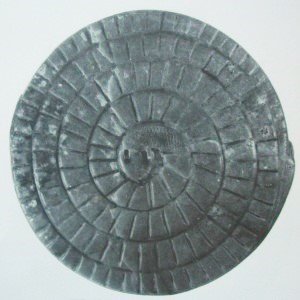
Researching ancient board games is a fascinating endeavor. They capture beliefs of the times and provide valuable perspectives into the lives and thoughts of people who played them. It’s even recognized board games hold origins for significant mysteries and symbols known today.
For instance, the first documented motif of the ouroboros, one of the most powerful symbols across the world, symbolizing eternal and cyclical natures of life by showing a serpent biting his tail, was of Mehen; a serpent deity of ancient Egypt, and the name of the oldest multi-player board game known (3000 BC). Both the Egyptian god and game shared the name, Mehen; and because the hieroglyph for the god’s name includes the symbol for the board game, it is not clear which acquired the name first; game or god. Either or, what is appreciated by this fact is how respected and sacred the board game Mehen was to Egyptians.
This reverence of course can also be discerned by images of the game being found on the walls of Egyptian tombs, included in writings of funerary texts, and the unearthing of actual Mehen game boards and pieces buried with the kings and other leaders of Egypt. The game is believed to have held deep religious significance.
One of the best examples for the game Mehen was discovered in the tomb of Hesay-ra. Hesay-Ra served under the Pharaoh Djoser as Chief of Physicians or Chief of Scribes in the third dynasty (approx. 2686BC-2613BC). This tomb was excavated in 1911 by Quibell and contained illustrations of three complete Egyptian board games; Senet, Men, and Mehen. Senet (passing) was another popular board game of the time and is known to share a similar sacred meaning to Mehen. Not much is known about the other game of Men (endurance), except it is suspected to be in association with the later game coming known as Hounds and Jackals.
The painting on the wall of Hesay-Ra’s tomb illustrates Mehen’s board and accompanying pieces. The board is in form of a coiled snake (Mehen means ‘coiled one’), with the head of the snake resting at center and its tail along the outer edge. Both the head and tail of the snake of the board are painted black with yellow lines. The body of the snake was painted yellow, and the assumed spaces for the game were created by painting red lines on the back of the snake as it coiled towards center. On this particular board, over 400 spaces can be counted. Although it should be noted here, there isn’t any standard to the amount of spaces found for Mehen boards. This suggests the number of spaces weren’t vital for actual game play.
The tomb drawings of Hesay-Ra also illustrate the game’s playing pieces. Six sets of six marble like pieces of different colors, with 3 lions and 3 lionesses, were shown. Along with later tomb depictions of 4 player’s enjoying the game, the pieces imply it was a game for more than just two players, and so the reason for it being considered the first multiplayer board game.
Complete rules for the game are unknown. None have ever been found. However, research into the god, Mehen, may offer clues to not only the rules of play, but of its purpose, and influence towards future veiled enigmas taunting us yet today.
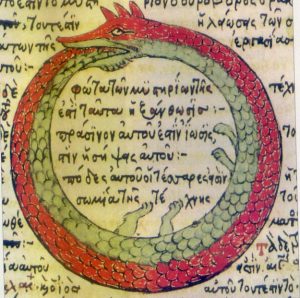
Mehen, the god, held an extremely important role for the rebirth of the sun god Ra on his nightly journey through the underworld. Discovered in the tomb of Tutankhamen (appx. 1300BC) was the text, Enigmatic Book of the Netherworld. This text was where the first appearance of the ouroboros was found, and that which describes the journey of Ra. During this dangerous trek of Ra, Mehen is shown wrapping himself around Ra as ultimate protector of him.
Mehen is the ouroboros.
It is believed by some, the spiral game board represents the journey with Ra, and that playing it would symbolize a player’s own struggles and eventual rebirth. It perhaps helped convey the cycle of life and taught how to overcome challenges so players could then better master them during their own journey through the underworld. Playing on the back of snake represented being accompanied by, and protected by, Mehen.
Only fourteen physical Mehen game boards have been found. These were of stone, faience, or ivory. But it is thought other boards of wood, leaving only their pieces, had deteriorated. Or even, possibly, the board was to be etched on the ground to play like other games were known to have done.
What is personally intriguing, though, of the 14 boards discovered, two of them show the depiction of a goose or duck head in place of the serpent’s tail on the outer edge. It begs the question of why. There is the theory it relates to the Egyptian creation myth involving the primeval goose. This goose laid the egg which when hatched separated Heaven and Earth, and revealed the sun god, Ra, born. But perhaps there is another meaning as well.
To try and answer this, it might be important to understand games were often created to teach on a more intimate level by allowing players to experience certain situations presented to them within the game. Play of game related much with ritual acts. And playing games, like ritual, shaped and influenced players’ thoughts and deeper senses. They taught. Today even, some origins of the word game can be traced back to meaning ‘school’. And it is interesting to mention too, spaces on a board game were often called houses.
Because of this I find an old Sumerian riddle noteworthy, and possibly connected to another layer of reason why a goose/duck head is found in place of the serpent’s tail on the Mehen game board.
In 1960, twenty-five Sumerian riddles were translated by E.I. Gordon. They dated back to writings on cuneiform tablets of the 18th century B.C. and embrace, like games, thoughts of the times.
One of my favorite is as follows (as translated by Gordon)
A house based on a foundation like the skies; A house one has covered with a veil like a secret box; A house set on a base like a goose. One enters it blind, leaves it seeing. What is it?
The answer given on the tablet is a ‘School’. We will get back to this soon.
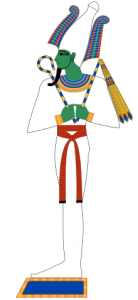
The journey of Ra with Osiris, as told in the Book of the Hidden Chamber, recounts the twelve hours of travel from dusk to dawn through the underworld. Each hour delivering benefit to gain towards eventual rebirth. The game Mehen is believed to be played by moving pieces from the outer edge (beginning at either the serpent’s tail or goose head) towards center, and then back out again. A player winning the game represented his rebirth, and him coming out of the darkness.
Half way through the journey with Ra, the sixth hour, is one of the most vital hours. It is here a union with Ra happens, recognized by Osiris’ union, rejuvenation and now green (new/rebirth) appearance in the sacred text. From here, the journey back out begins. It is a turning point. The game’s turning point is at center as well, and at the serpent’s head; a dangerous and dark place to be. Think of Eden.
To go back to the Sumerian riddle, similarities to the journey of Ra, and the game of Mehen, certainly can be noticed. In commentary for the riddle, another translation for ‘skies’ is ‘god’s abode’, and a player moves (enters blind), to have union with the god, Ra, in a hidden room (veiled like a box), from beginning at the head of the goose (base like a goose).
One enters it blind, and comes out seeing. A player moves through darkness, through the night, symbolizing the inability to see/need for learning, and finally turns, has union with the god, to return to the light in rebirth, and able to see. I find the likeness captivating. The belief for the need of Journeying through darkness towards light for gaining wisdom seems like a belief well shared, still today.
There is something else that causes me to pause too while exploring this ancient game of Mehen. If we go back to the tomb of Hesay-Ra and consider the colors the board was painted, other remarkable representations can be realized.
It was said both ends of the game were painted black with yellow. Perhaps this is so because darkness (portrayed by black) is most prominent here; before entering, and before union. And yet, there is yellow, signifying hope, for light to be found. The body of the snake was said to be yellow which could easily be understood as the path of light through darkness. But what of the red marks?
Here we must go down another quick path of research on the game. But we will come back with a most incredible possibility and conclusion.
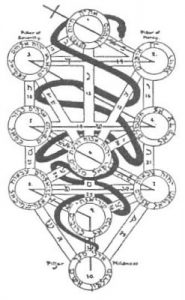
Peter Piccione, an established researcher of Egyptian games, has found the Egyptian Coffin Texts make possible reference to ‘Mysteries of Mehen’, which he feels is a secret body of knowledge. Within the texts are spells, such as ‘Make way for me; open the gate for me, you who are in Mehen’, ‘I am acquainted with his enemies which are in the gates. I know the roads of Mehen’, or ‘As for one who knows the name of those, his roads, it is he who will enter Mehen.’
Piccione goes on to share reference made to ‘fiery breath and roads’ and that the roads of Mehen are actually this. Those who want to travel must go through the fiery roads and follow the roads of Mehen. He notes in one spell of how the roads of fire are depicted in red paint, and on these roads are gates that guard and turn away those not worthy to pass. One can only continue if they have learned the secrets or gained knowledge to do so.
From this it can be proposed the red marks of Hesay-Ra’s game illustration portray the gates, and the roads of Mehen or the path of fire is the course of the game track.
Passing through fire has long been recognized as a purifying method. It is seen as a way to offer new life since time began; and for me this reference to the roads of Mehen (gates of fire- which are guarded from those who do not know and therefore cannot move forward) make me think of the path of fire, or Lightning Flash, through the Tree of Life. This is often depicted with a serpent coiling around it.
The diagram of the Tree of Life symbolizes God flowing down to man, and offers a path for man to reach back up. Following this zig-zag path of fire, man passes through and learns various attributes of the sephiroth, to eventually acquire high wisdom.
It isn’t a stretch to speculate that there is a connective line of thought between the two; the Tree of Life and Mehen. Especially when the lightning flash on the tree of life can be seen as the flaming sword in the following verse from Genesis:
Genesis 3:24; “After he drove the man out, he placed on the east side of the Garden of Eden cherubim and a flaming sword flashing back and forth to guard the way to the tree of life.”
Man must pass through the flaming sword, or the lightning flash, to reach life/achieve rebirth. It’s interesting to me, as mentioned above, in the spells of the Coffin Texts there is mention that you can be turned away from the gates if you do not know the secrets to pass. And the board game of Mehen seems to clearly depict ‘gates of fire’ to guard the way to life/rebirth; like the Garden of Eden and Tree of Life does. (This ‘turned away’ echoes a Talmud legend I wrote about here: Alexander the Great and the Gates of Paradise)
The mysteries and secrets of Mehen are many, and it seems to me, as one of the first games revered, it had influence on future thoughts of players. From these inspirations are other creations and representations that might ultimately be realized to coil back to Mehen; the god of games, and symbolically life.
I’ve enjoyed sharing with you and do invite your thoughts. I feel we are all on a quest for further understanding and knowledge, and so please feel free to offer insights you might have on this interesting subject matter.
.

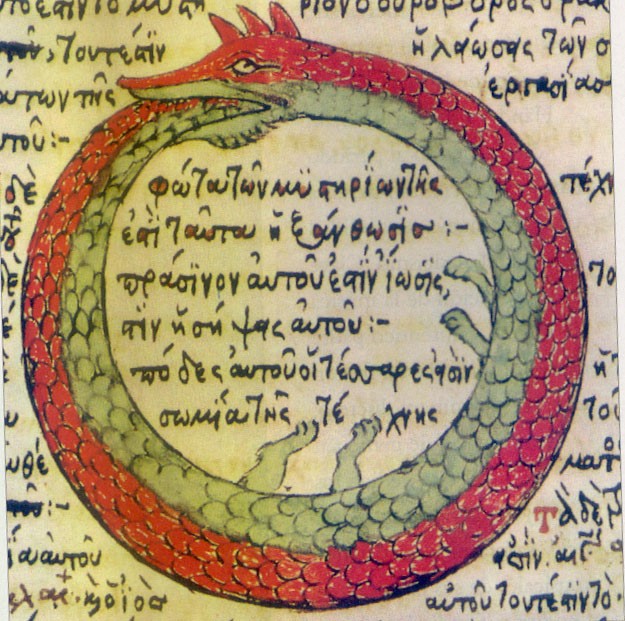
The spiritual teaching aspect reminds me of the Native American dolls, which Forrest told us were to teach the kids the ritual dress for their gatherings of different types.
The concept of a great serpent seems to be all around the world in many cultures.
The Gates of Paradise or some entrance to the spirit world is too.
The Tree of Life concept too.
It’s interesting to imagine how people from the past tried to make sense of their own spiritual progress.
Samadhi documentary on Gaia is interesting. Covers this topic of serpent eating its tail.
The game survives to this date as the Game of the Goose. I used to play it as a child. And I can testify that familiarity with it does help somewhat in the spiritual quest.
The game actually represents a snake coiled around the cosmic egg. The snake is yellow because it’s the trajectory of the sun, and it’s set against the black of the sky. Ancient Egyptians knew about eclipses, and that the day sky is blue because of the light of the sun, because during an eclipse it goes black. As for the red lines on the snake, they are the red gates of twilight, during sunset and sunrise.
Sunrise and sunset. Thanks Maria. That actually adds an image to the thinking and where it comes from.
But your comment about the blue sky leaves me wondering if there’s something more. Because the sun, being yellow, you’d think the sky would be golden without something more to cause it to turn blue (in a mythological sense).
I get the feeling here, like with so much else about ancient theologies and myths, that there’s a bunch of stuff that relates to other ancient religious concepts.
Thanks for your opinion, Maria. There isn’t any conclusive evidence what you state is fact, but I like your ideas.
Alexandrians knew the world was round a long time ago. I believe they used two shadows and measured the difference. It doesn’t surprise me that they had cool games. Thanks Maria, I will have to google your sunrise and sunset etc thoughts.
yoou made a comment about the game being for the hereafter, you are correct in that assumption, the two snakes are passageways one to heaven and one to hell, I have seen these first hand and have been down them several times ever since I died 30 years ago, I now live in both worlds and see the answers left for man.